Introduction
Theoretical Framework
The theoretical framework introduces and describes the theory that explains why the research problem under study exists. The relevance of improving corporate culture is determined by the increasing influence of the human factor: the “aging” workforce, which leads to a decrease in the level of the economically active population. In addition, the peculiarities of the Millennial generation, seeking to change jobs frequently and being in a group of high unemployment rates. Every organization strives to achieve a high degree of team cohesion by increasing interest in the success of both the team and the company as participants in the social process. Properly built corporate culture has a direct impact on the company’s performance. It is one of the key components to achieving goals and strengthening the role of the social component in the motivation of employees. The innovation activity is a strategic direction of airline competitiveness increase, connected with commercial use of new equipment, technologies, and intellectual potential of the personnel. Innovations make it possible to form new market segments (market niches) due to improved or unique characteristics of the transportation product and reduce its cost.
The factors that affected the choice of the theme are explained by the fact that the culture of an organization can either support and encourage innovation or hinder it. It can encourage workers to develop and implement innovations or discourage them from doing anything new. The degree to which organizational culture supports innovation varies significantly across different companies. Therefore, due to the firm’s size, organizational culture, and management at Turkish Airlines is an interesting field of study. This is because the company has many different employees among whom data collection such as questionnaires and face-to-face interviews can be conducted.
These provide a statistical assessment and apply Geert Hofstede’s model for data analysis. The target audience that could potentially be interested in the research is all companies operating in the passenger air transport sector and Turkish Airlines in particular. The theoretical basis of the study consists of scientific articles related to organizational culture and innovation management. The thesis provides sections such as a review of sources to substantiate previous work from this theme. At the same time, the methodology and chosen research methods to collect the data. The findings, discussion, and conclusions section present the research results.
Statement of the Problem
The context of the problem is to investigate how, at the present step of development, changes in the management of the chosen organization through the study of organizational culture. A revision of management priorities characterizes the current development period of the aviation business in Turkey. The difficulties of human resources management come in the first place. It is gradually beginning to be understood that it is necessary to consider their characteristics and culture when interacting with personnel. In the vocabulary of modern Turkish management, there is such a concept as organizational culture, and it becomes understood that the corporate culture affects the administration in any company.
Purpose of the Study
The research aims to analyze the organizational culture and its influence on the innovation management of the enterprise “Turkish Airlines”.
Research questions
The research questions are designed to establish following issues: what is the development of corporate culture at Turkish Airlines? What is the current state of organizational culture in the organization? How important is the factor for management? Which recommendations can be made to improve organizational culture for more effective innovation management?
Significance of the study
The significance of the study results from the fact that the system of values within which Turkish Airlines operates is based not only on its economic functions but also on the culture of economic activity of its managers. Organizational culture is one of the leading factors that directly impact the processes taking place within the organization, determining the style and way of activity of the organization, the characteristics of interaction between employees, requirements for workers, and attitude towards them. Thus, it is essential to establish a relationship between organizational culture and innovation management to ensure the company’s effective functioning.
The value of the research also is that it applies quantitative and qualitative data for data collection and analysis of existing literature. Its originality is specifically in its qualitative data collection, which allows for a comprehensive study of the level of organizational culture development in a particular company rather than in the industry as a whole. At the same time, this research will also conduct a synthesis of previous studies, which will provide recommendations for establishing an organizational culture and establishing innovation management. The potential contribution of the study is that it aims to establish the real state of organizational culture and its use by managers. At the same time, the research is conducted in the aviation sector aimed at transporting customers, so it is exposed to competition. The prospective impact of the study is also to provide guidance to the company on how to use effective and innovative management for the business’s success.
Definitions
Organizational culture, as a social innovation, allows for different organizational configurations in accordance with the needs of innovative development of the company and form the appropriate motivation for their implementation. At the same time, conscious and goal-oriented management of the processes of cultural development at the enterprise enables the leader to influence the innovation activity of the staff essentially. Corporate culture is a set of general concepts and approaches to the organization, forms of relations and activity results, which distinguish the organization from others.
Innovation management is an independent branch of management science and professional activity. It aims to form and provide conditions for the innovative development of any organization. Innovation management is a combination of innovation process management and change management. This applies to products, business processes, marketing and organizational innovation.
Company “Turkish Airlines” is the primary air carrier of the country and has the most extensive route network among Turkish companies. It flies to more than 120 countries around the world. Turkish Airlines has a large and modern fleet of more than 200 airliners, regularly updated. A comfortable arrangement of passenger seats characterizes aircraft. Turkish Airlines generally focuses on the quality of on-board service.
Literature Review
The formation and maintenance of competitive advantage affect all elements and business processes of the organization, associated with the creation, production, and sale of developments. It is due to the fact that a competitive position in achieving the best quality of service can often be realized only with effective direct “seller-buyer” contact, which, in turn, depends on the formed organizational culture (Felipe et al., 2017). In the existing conditions of market economy development, the way out for originating the competitive potential of most enterprises is implementing an innovative management system.
The primary purpose of corporate culture in an innovation-oriented enterprise is to achieve high performance and elevated results by improving human resource management. It should be grounded on employee loyalty to the company management and decisions, changing the attitude of personnel to the organization as a whole as a common sphere of interaction and realization of interests (Rajapathirana and Hui, 2018). The essence and content of the concept “organizational culture” can be revealed through its functions. According to Rajapathirana and Hui (2018), the first is realized through a set of values; it contributes to a better organization’s interaction with the external environment. The second function is aimed at the relationship within the organization, to create a spirit of cooperation, mutual assistance, joint norms and values, the system of rewards and punishments for staff.
The competitiveness and efficiency of an airline company nowadays are primarily determined by its ability to adapt to the conditions of the market economy and implement innovations to maintain a leading position. Based on the analysis of the world’s leading airlines, Al-Azri et al. (2015) remark that the most successful ones have one thing in common – a well-developed organizational culture. Their leadership and principles make it clear that success in the marketplace is primarily the result of the combined efforts of all of the organization’s personnel (Al-Azri et al., 2015). Taking care of people, the atmosphere of trust and openness, creating conditions for disclosure of talents – are the integral components of the corporate culture, which can bring quite tangible financial results.
Thus, organizational culture is one of the fundamental elements affecting individual and corporate results or processes. However, there is no consensus in the publications regarding the very definition of organizational culture (Elsbach and Stigliani, 2018). Researchers correspondingly note that because of its variability and ability to adapt to different conditions, culture is a phenomenon that cannot be described accurately and completely. They state that organizational culture needs to be studied from different perspectives since one-sided studies cannot provide accurate results. It should be mentioned that analysis and research on this topic became widespread back in the 1980s when the issue of the relationship between culture and other organizational variables received particular attention. It can be explained by the increasing role of organizations in the international arena. According to Schmiedel and Brocke (2019), this period was the first wave of scholarly work on the impact of culture on employees and organizational performance in general. Definitions take different forms depending on the concept; they reflect the perspective approaches and emphases of the authors.
Consequently, scientific papers and practical experience of the ’80s revealed two opposed approaches to defining organizational culture. The first is that the meaning should be understood as an internal subsystem that allows physical entities to adapt to the environment. This approach means that the company has its own culture, which is descriptive and includes personality traits. In the second approach, the company is seen as a culture, a system of knowledge that each of its constituents can interpret through their minds (Chatman and O’Reilly, 2016). It, in turn, allows access to the dynamics of the social system in all its complexity and then leads to the concept of corporate identity.
However, other researchers such as Akpur and Kemal (2021) state that between 1983 and 1986, different interpretations of the terms emerged, whereby the previous ones have lost their relevance as they no longer respond to the global environment. Therefore, it is necessary to use more modern interpretations for a qualitative definition of organizational culture. For example, Sürücü and Yeşilada (2017) believe that under its meaning should be understood the beliefs, assumptions and most notably – the values that are shared by all members of the group. They include the rules of conduct, type and style of leadership, as well as administrative procedures and customs. Jitklongsub and Suveatwatanakul (2020), in turn, defined organizational culture as the philosophy, ideology, values, assumptions, beliefs, and expectations shared. Other accept that corporate culture should be compared to human invention, which creates an atmosphere of solidarity, fullness and commitment and productivity of all actors who move towards the same goal.
It is also worth noting the definition that comes down to understanding the organizational culture as a system of shared values, goals and beliefs. They depend directly on the organization’s teams, its internal structure and its control system, which establishes behavioural norms that are necessary for the viability of the organization (Chen et al., 2018). They believe that the central role in the interpretation of the concept should be given to the external environment, which must necessarily meet and adapt to all the factors on which the company depends. Ali et al. (2017) provide a definition that most authors would agree with; they interpret organizational culture as a holistic organism that has developed historically due to the leaders or founders. The authors state that it is social and challenging to change as it necessarily consists of people whose everyday activity leads to achieving goals.
It is significant to mention that the organizational culture directly affects the results achieved by employees or managers in a particular company. Okatan and Alankuş (2017) agree that it affects employee behaviour, learning and development, creativity and innovation. Thus, the definition of organizational culture, which has been widely accepted in scientific development by researchers interested in this field of knowledge, allows one to formulate it more precisely. Culture is all the fundamental assumptions and ideas that a given group has invented, discovered or developed in the process of learning to solve problems of adaptation to the environment and internal integration.
These definitions have been repeatedly tested and proven by it to such an extent that they can be considered relevant and accurate. Therefore, they can be instilled in every new member of the company as a proper way of feeling and perceiving the right direction of thinking about teamwork problems (Caber, 2018). Something cohesive and common elements can be found in all of these definitions. They emphasize the participants’ assumptions, norms, values, and the resulting ways of acting or behaving. It is a kind of mental community, understood as the foundation of all organizational activity and underlying the specific tasks that the organization must address.
The passenger air transportation market is highly competitive and subject to the influence of many external factors. At the same time, the successful functioning of airlines requires them to be customer-oriented, which is only possible within the framework of implementing an effective strategy based on a solid organizational culture of the company. The corporate philosophy of Turkish Airlines, which includes both mission, values and basic principles of work, is a kind of ideological platform on which all its activities in the field of corporate culture are based (Maden, 2013). Its primary vector and reference point is people, particularly passengers. Therefore, the primary duty of all Turkish Airlines employees is to help their customers. For this purpose, the company’s corporate philosophy includes the development of competence, constructiveness, teamwork, understanding of the significance of relations with passengers, orientation on the satisfaction of client’s needs and continuous improvement of service quality.
It is also noteworthy that the concept of organizational culture is directly correlated with many other phenomena, one of which is innovation. In order to understand their relationship, it is essential to dwelling on the concept of innovation, particularly in the field of air travel. Alagöz and Ekici (2014) see them as a fundamental method capable of influencing a company’s competitiveness in domestic and international airlines and one of the main ways to improve an airline’s image. They state among the distinctive features of airlines’ innovation activities, the absence of a development phase related to the development of new aircraft, specific functional orientation.
The term “innovation” itself has its roots in the Latin expression Novus or “new”, so one of its alternative interpretations is reduced to an innovative idea, methodology or development. Innovation has also been defined as the process by which new practices and techniques are introduced (Hammoud et al., 2017). They can also be interpreted as the development and further implementation of previously unknown ideas by workers who, over time, enter into business transactions with other physical actors in facets of the institutional, legal order.
For innovation to be practical, it must be encouraged and correlated with other relevant norms and support systems. Okumus et al. (2020) argue that they are the engine of progress and change, with organizational culture as the fundamental element that defines innovation. They consist of diverse forms of activity to provide value to the target audience and sufficient profit for the organizations. Adiloğlu-Yalçınkaya and Besler (2021), in turn, note that innovation is one of the most critical functions of any business. Any company that plan to generate profits should consider them as a means of achieving and retaining a strategic competitive advantage.
In order to determine whether an institution is capable of innovation, a comprehensive set of company characteristics that drive and facilitate innovation strategies must be examined (Aldemir et al., 2021). Innovation capability consists of creating and implementing new technological capabilities in the field of practice. The term encompasses a range of activities, from a predisposition to invent to improving existing technology beyond the original design parameters (Battal and Polat, 2020). It is also important to note that innovation capability directly affects the productivity and viability of its operations in several ways.
A company’s capabilities are critical to gaining and maintaining a competitive advantage and expanding in any market (Gemici and Alpkan, 2015). In particular, the capacity to innovate is directly related to several strategic advantages. For example, they noted that sustainable competitive advantage could be achieved by continuously improving independent innovation capability in companies. Thus, innovation is related to the organizational capacity to transform new ideas into commercial and social value. It correlates with a wide range of elements and therefore is influenced by various internal and external factors (Arena et al., 2017). Although innovation is a complex concept, research highlights five key areas that affect an organization’s innovativeness. These elements relate to leadership, opportunistic behaviours; culture and change; learning; and networking and relationships.
It is also important to note other studies in this area, particularly those that address issues of innovative business models. For example, Zaim et al. (2013) argue that the business model of any organization will be effective only when it has an element of innovation. They also note that business model innovation can increase operational efficiency and double its profits. Doğru (2021), in turn, explains that innovation, organizational culture and business are very closely related. Though in order to innovate, it is not necessary to change the concept of the company and come up with new development or service. It is enough to change the way of offering and part of the workflow, and then productivity will improve significantly. Demir et al. (2021) add that innovation is vital for the airline industry because these players are subject to high competition.
Particularly after the state control over this sector decreased, airlines have set a goal to serve many passengers at low prices to get customers’ love. Peksatici and Ergun (2019) believe that traditional airlines tried to stick to their conventional airline models, but the direct result of such actions was decreased demand for services, which led to the need for change. Ahmedian and Soran (2019) found that different organizational structures affect airline recognition in the aviation industry. They concluded that those that are innovative increase the company’s market value. They define innovation as a way for airlines to succeed in today’s world. Karasar and Öztürk (2014) analyzed innovations, dividing them into new business models, new technologies, and improved passenger classification to understand their needs and expectations. They also noted that airlines struggling with crises worldwide could manage their process by cutting costs as usual and through innovative models, customer classification, and new technology.
The search for the most influential innovations because of the above is a complex task that requires processing a significant amount of information. The structure of innovation activity can be represented as an “innovation pyramid”. The pyramid’s base (the lower hierarchy level) defines the static organization, its essential elements. The upper level of the order determines the dynamic organization and the innovation process. Areas of adaptation of organizational structures to innovations can be: the creation of staff units, providing coordination of work on the development and implementation of innovation (Taskinsoy and Uyar, 2017). They also include additional functions of structural units, associated with new responsibilities and powers of heads of departments; restructuring of the management system, changing the patterns of communication. In huge, enormous and partly medium-sized airlines, it is advisable to create elements of the organizational structure engaged in innovation activities permanently, in small ones temporarily.
The airline chooses the object of innovation, which corresponds, as a rule, to the already established composition of preparatory activities. For example, opening a new airline, connection to a new booking system, and air transportation sales are a well-regulated set of measures determined by supplying companies, state regulatory bodies, and the airlines themselves. Innovations are always associated with changes in the way an airline company operates (Kurt et al., 2013). The organization of an automated search process can be based on the sequential enumeration and analysis of possible combinations of changes in the directions of functioning of the enterprise. The algorithm of such an information system is based on the processing of change keyword sets and databases.
It is equally important to support the creative activity of personnel in terms of innovative proposals, which implies the creation of an environment in the company that is favourable for innovation and the use of methods for generating new ideas. A good environment occurs if: management is receptive to new ideas; working contacts between employees are encouraged; working groups of employees from different departments are created when solving problems and conducting new developments (Inan, 2018). An innovative culture is unthinkable without a creative atmosphere that encourages employees to develop new things; the principal value is the ability to work creatively. Solving problems creatively is the most important quality of modern management.
A particular organizational structure of management is needed to form an innovation culture based on the principle of flexible response and new perception (Suifan, 2021). For this purpose, project or program-targeted structures and their combination with traditional functions are used. An essential condition for the organization of innovative activity at the intrafirm level is entrepreneurial autonomy, granting freedom to individual structural units of the enterprise.
Ahmetoglu (2018) notes that Turkish Airlines is one of the companies where organizational culture is closely related to innovation management. It provides domestic and foreign cargo transportation to the most significant number of destinations. He states that the company plans to achieve this by acquiring high-tech, fuel-efficient and environmentally friendly aircraft that provide high levels of comfort. Raharjo (2018) also notes that with an unrivalled route network, a young and modern fleet, comfortable seats and delicious food, the company has earned Europe’s Best Airline. With great enthusiasm and ambition, they fly to almost every country globally.
Karaman and Akman (2018) make the statement that knowledge and intellectual activity are crucial to an organization and are the source without which no complete action is possible. He also believes that the organizational culture and innovation management process in Turkish Airlines is inextricably linked. Furthermore, innovation management in this company aims to manage the positive and negative functions of critical knowledge in various activities, define new strategies and new products, strengthen human resource management and meet several objectives or goals.
Over the years, the organization has been at the forefront of innovations emerging in the airline world, from renewable biofuels and new aircraft to advanced operational tools and in-flight entertainment systems. To maintain its leadership position in the industry and its ability to provide world-class customer service, the company had to increase its workforce and implement modern IT practices, including Agile and DevOps (Edwards-Schachter, 2018). Such transformations are challenging for any company, and they are particularly challenging for an ever-growing multinational corporation.
In general, most authors consider theoretical aspects of the organization’s corporate culture, and the presentation of results of empirical research is comparatively low. Scientific research also deals with the concept of innovation, but at the same time there is insufficient explanation of its practical application. This is explained by the complexity of studying the internal environment of the enterprise. After all, visually, it is possible to observe only external manifestations of corporate culture, and interior – ideas, attitudes, values, beliefs – are studied through special techniques, conducting surveys of company personnel. That is why there is a need for a comprehensive study of the organization, the organizational culture of which is in close contact with innovation.
Methodology
Research Design
The research will employ a sequential design because it allows investigating the opinions of a whole group of people over a specific period. The study will use the interview and survey method in order to obtain truthful information from employees about organizational culture and its impact on innovation management.
Target population and participants
It is essential to discuss the characteristics of the research participants. As already mentioned, to understand how developed the corporate culture is, and its influence on innovation management at Turkish Airlines, a questionnaire survey and face-to-face interviews of employees in three structural units of Turkish Airlines were conducted. These divisions include the Marketing and Sales Department, Financial Department and Flight Operations Department. These departments were selected to cover a more significant segment of employees. Therefore, the study in 3 departments provided information about organizational culture and its impact on managers’ application of innovation management and to what extent.
The target group was 200 employees from marketing and sales, 180 finance employees, and 300 flight control personnel. It is also crucial to identify that the representation of the articles was in a 50/50 residual ratio. At the same time, employees of different genders who varied in socioeconomic status participated. Thus, in addition to rank-and-file employees, assistant managers were also involved. Moreover, workers with different ethnic backgrounds, such as Greeks and Kurds (50 workers), participated in the research.
In order to guarantee the anonymity of the questionnaire, measures were taken, such as giving each participant an identification code for the study. Therefore, their answers were recorded under the cypher code rather than the participant’s last name. However, during the face-to-face interviews, each participant was given an identification number ranging from 1 to 680. Accordingly, the interviewer did not know the respondents’ data, maintaining anonymity. Significantly, the files containing electronic data were password-protected and encrypted. Hence, it was impossible to establish which precinct belonged to which answer; as a consequence, due to the guarantee of anonymity the participants answered the questions honestly through.
Procedures
Data collection instruments
In order to understand the degree of the corporate culture at Turkish Airlines, the employees of the three Turkish Airlines departments (Marketing and Sales, Finance, and Flight Operations) were questioned, and five questions were asked to the staff. A total of 680 individuals participated in the research. The questionnaires were distributed to all the employees of the departments, and those who wanted to participate in the questionnaire filled out the forms during the week and dropped them in the specially installed boxes.
The questions were chosen in such a way as to establish the percentage of employees’ satisfaction or dissatisfaction with their work in the company. At the same time, the questions that participants received in the form of questionnaires are standard for such studies. They provide an accurate answer to the question about the current state of organizational culture and whether leadership influences management practices to be more innovative. What do you expect from your company in the future? How long have you been with the company? Would you say that the people you work with are a team? Do you enjoy working at Turkish Airlines? Does management examine the state of team cohesion and introduce an innovative manager based on that?
One more method used in the research is face-to-face interviews. It was chosen in order to get answers to the questions of organizational culture development in the organization. During the week, the employees were interviewed via Skype at a convenient time. Each of the participants was offered to give answers to questions that directly concern the company’s culture and division of the company’s values and the use of certain types of motivation in the enterprise. Specifically, the following questions were given: Do you know the history of your company? What is the mission of the company? What meaning does the very concept of organizational culture have for you? What recreational activities do you have in your organization? What material and tangible assets are core to your organization? It is essential to mention that this data collection method was conducted after the questionnaire, so the same 680 people took part in it.
Data analysis procedures
After two preliminary data collection steps were conducted, experts were brought in to conduct the Hofstede model analysis. This method of data analysis was chosen because of several significant factors. In order to evaluate organizational culture, G. Hofstede introduced special parameters that assess people’s behaviour (Doğru, 2021). During the investigation, the following criteria are used: individuality and collectivism, which characterizes the degree of a grouping of people; power distance, which describes the degree of inequality between management and subordinates; masculinity and femininity, which reflects the division of labour functions into male and female. Typology of organizational cultures is a variant of cognition of cultural types. The mode is implemented by the method of decomposing socio-cultural systems and subjects into types on a generalizing basis.
The mentioned aspects of cultural dimensions enable one to understand the functioning of different national cultures, which can coexist in one company. However, the principal value of this theory is the possibility of applying the knowledge of cultural dimensions in management. Thus, after the analysis with the aid of the model, it is possible to provide recommendations to improve the organizational culture in order to enhance innovation management.
Reliability and validity
In order to provide and validate the reliability of the research, a clear plan for conducting the questionnaire and interviews was created. It is essential to mention that the questionnaire survey was anonymous and voluntary; all employees of the three departments had the right to refuse. Accordingly, thus this generated a sample of respondents who threw questionnaires (encrypted) in a special box during the week. The reliability of the study can be explained by the fact that, as noted above, the sample of respondents is comprehensive, which allows investigating the impact of organizational culture on innovation in different departments. At the same time, the validity of the research is also confirmed by the fact that the same respondents also participated in an interview that took place via Skype (at a convenient time for each interviewee).
Although the questions were different in the two surveys, they addressed the same topic of organizational culture and innovation management. Hence, collectively, after analysis using the Hofstede method, it is possible to establish a recommended action plan to address the deficiencies. Accordingly, the validity and reliability of the research is due to the fact that through a single sample and a question on a similar topic, it is possible to establish the truthfulness of the data. Moreover, the application of the Hofstede method makes it possible to establish the factors affecting the level of organizational culture in a complex way and determine their impact on innovation management at Turkish Airlines.
Limitations
Limitations of the study are that Turkish Airlines has an expanded structure and many divisions. In order to collect more data, it would be required to develop the sample. Due to the lack of permissions and technical capacity, the study was limited to only 680 employees in marketing and sales, finance and flight management. At the same time, the data collection did not include the company’s regular customers. They would have been able to assess whether innovation management was being implemented and how it affected service quality. Although, the choice of instruments and the sampling is enough to investigate the state of organizational climate and its impact on innovation management from employees’ point of view in different departments. Thus, the threat of internal validity was minimized by the fact that the small sample size for the company scale included various categories of staffers.
Findings
The answers to the questions concerning Figure 1 can be analyzed as follows. According to the received responses, 34% of employees enjoy or rather enjoy (36%) working in the company. Those who categorically do not like working at Turkish Airlines are only 6%, but there are 24% who are dissatisfied with something, and they rather do not like working at Turkish Airlines. Still, at the same time, they do not choose the categorical form of denial. This category of staff is more likely to be hesitant for now.
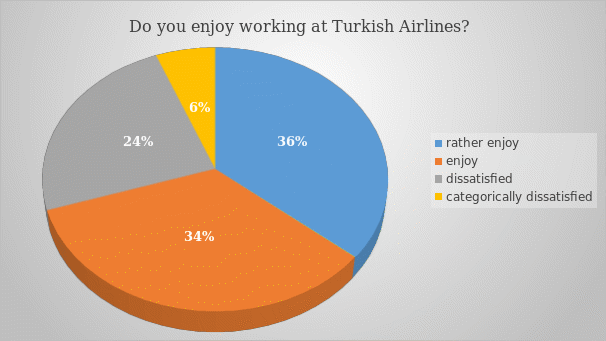
The answers to the second question are represented in Figure 2. The staff’s answers about the presence of a team were divided roughly evenly: into those who consider their surroundings a team (22%) or rather consider it a group (31%) and those who deny the presence of team spirit in the team. Those who categorically deny the reality of the team spirit are 17%, those who hesitate in their choice and do not fully recognize the team are 30%. Such a scattering of answers indicates the disunity of the team and the need to increase corporatism.
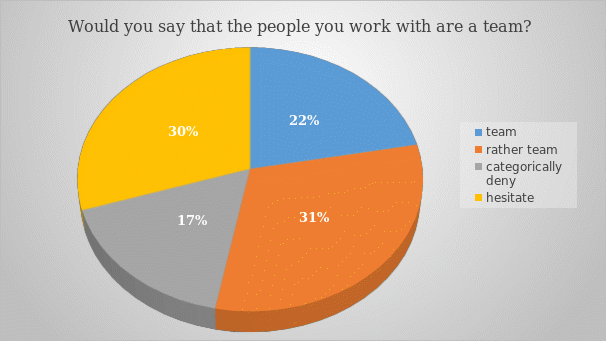
Figure 3 shows the results of a question about whether management explores the state of team cohesion and introduces an innovation manager based on that. From the suggested factors, it should be noted those factors that are not yet sufficiently used to improve the company’s efficiency.
From the results obtained, it follows that the least used elements of leadership belong to the presence of team spirit (67%), and a large number of responses were in the position of “willingness to take responsibility” (63%).
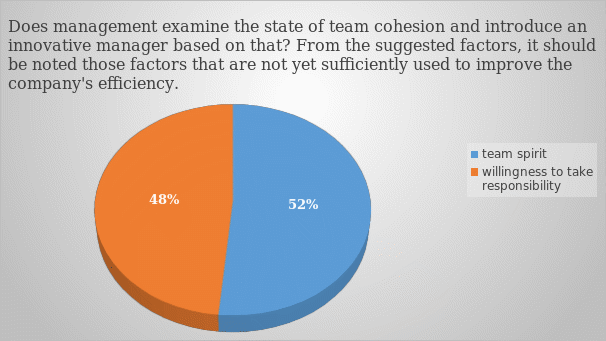
The outcome of the following question is presented in Figure 4. The staff’s answers to questions about expectations for the future yielded the following results. The greatest expectations are caused by the work in the team (32%) of responses; the next important criterion was: “good social support” – 29%, the least number of answers was “good relations with colleagues” – 18%, which is a good factor in itself, as it does not cause a desire for great changes; and guarantees to keep the job 21% expect, which means they are afraid of losing the job, so it suits them.
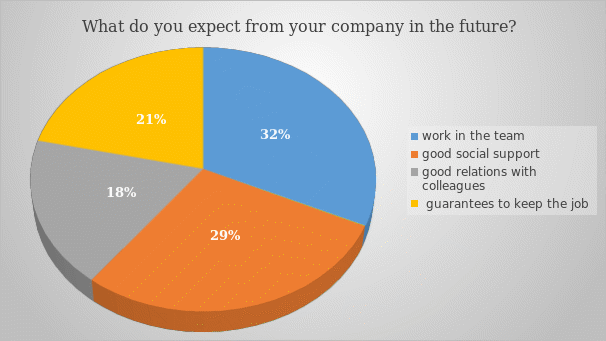
The answers to the fifth question are shown in Figure 5. In order to better understand the position of the staff participating in the survey, it is necessary to know how many years each of them has worked in the organization. The structure of respondents looks as follows: most of those who voluntarily took part in the questionnaire are people who worked in the company from 5 to 10 years – 64%, those who worked more than 10 years – 16%, those who only recently worked less than 5 years – 20%.
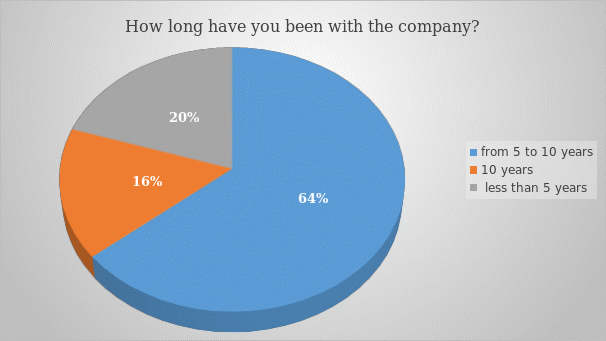
Thus, the analysis of corporate culture showed well-developed elements of corporate culture, such as effective communications, corporate identity, the presence of developed and implemented aspects of the personnel management system. There is also a problem – the staff is not sure that they are a team. The questionnaire showed that there are factors of organizational development that require immediate implementation.
The results of the face-to-face interviews:
Employees’ answers to questions about their knowledge of the company’s history are presented in Figure 6. Of the 680 employees who participated in the interviews, 76% said “yes”, 14% said not well enough, and 10% said “no”. Participants number 4, 100, 232, 611, 732 also stated that they separately researched company history to improve knowledge and, as a result, job performance. While respondents numbered 564, 284, 23, 7, 16 emphasized that they learned about the background from management. At the same time, participants number 1, 65, 82 did not know any additional information about the company at all. This is a good result, employees are interested in the history of the creation and development of their company, and they care about the place where they work.
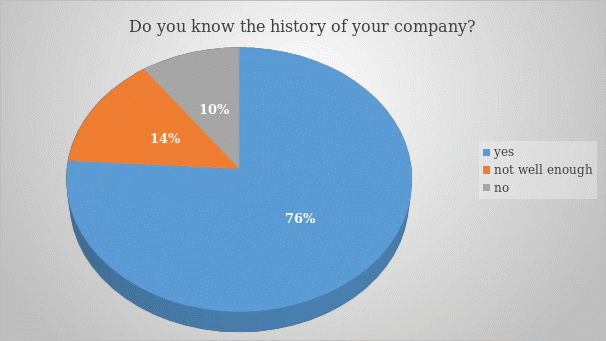
The answer to the following question can be analyzed according to the indicators presented in Figure 7. Turkish Airlines employees have a relatively good idea of the company’s mission. 38% have a clear understanding, 47% are unclear, and 15% of employees have no idea. Although most staff have an idea of the company’s strategy, it is still not enough for such a large enterprise. It is important to note that participants number 2, 21, 31, 87, 93,182, 543, 680 noted that the company’s mission is close to them in spirit, and they support it. At the same time, respondents number 621, 497, 73, and 9 did not know that a mission existed at all.
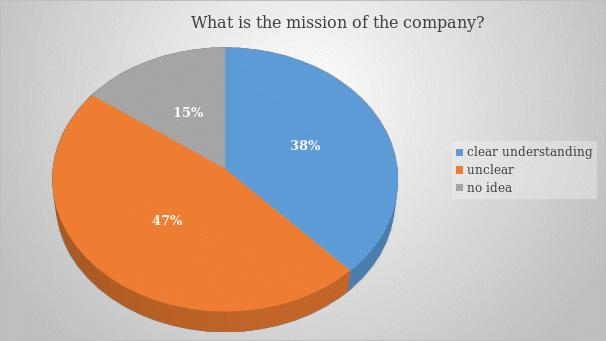
Figure 8 provides an analysis of the responses provided by the participants in the research. Employees’ opinions on the concept of “organizational culture” are divided. For some, it is a joint rest with the management (19%), for others – social assistance (25%), for third – the presence of signs of the enterprise (28%) and a set of traditions and rituals (28%). It should be mentioned that one of the principal qualities for the staff is social assistance.
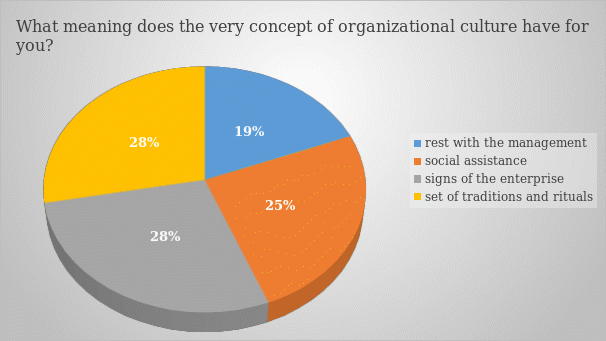
The analysis of the answer to the next question can be conducted as follows. Only 79% of the 680 respondents know that their company has written rules of conduct; accordingly, 21% do not know. This is undoubtedly a disadvantage since every employee should be aware of the rules of conduct. The central place in the joint leisure time of Turkish Airlines employees are sports competitions (46%), trips to the countryside (17%). This indicates that staff support a healthy lifestyle. There are also employee anniversaries (18%) and other types of recreation together (19%). These types of events have a positive effect on work productivity.
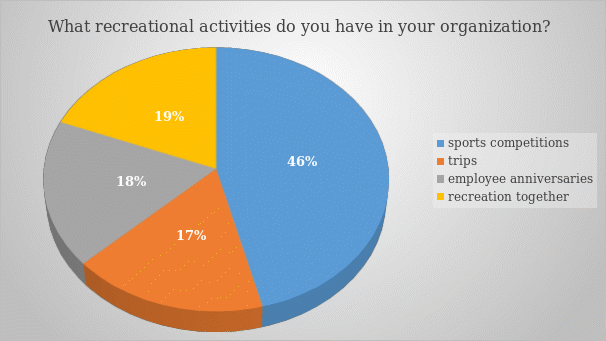
Figure 10 allows evaluating the answers of the interviewees to the last question. For most workers, the essential forms of material incentives – 45%, the least important is an additional payment for the length of service at the company – 10%. The most meaningful forms of non-material incentives are moral rewards – 25%, corporate holidays and social incentives – 20%. Participants numbered 333 and 471, 501, 565, 616 also indicated that they provide material and non-material incentives at the highest level. While respondents numbered 12, 45, and 301 said they did not know about incentives.
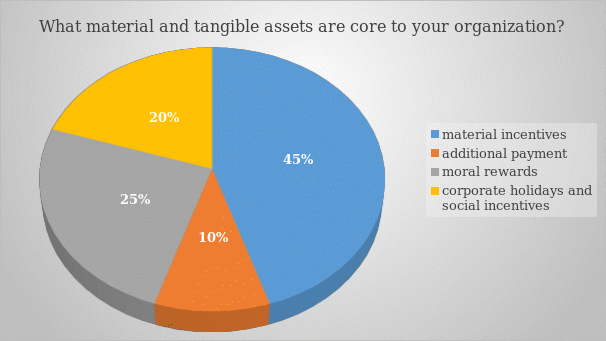
Table 1: Results of the Analysis of Organizational Culture according to Geert Hofstede
The above analysis provides sufficient grounds to state that the corporate culture of Turkish Airlines, both locally and generally, is characterized by its flexibility and resilience to changes in the external environment. This corporate culture values loyalty to the common system of values, encouraging experience and professional merit of subordinates.
Discussion and Conclusions
Discussion of Findings for Research Questions
According to the outcomes of the questionnaire, it is possible to answer such research questions as the development of organizational culture in Turkish Airlines and the state of corporate culture in the company. It is significant to mention that only about 30 per cent of employees believe that they work in a team. The specified result is negative because another 17 per cent confidently state that there is no collective spirit in the group, and 30 cannot give an answer to this question. Considering that workers who have been working at Turkish Airlines for more than 10 years typically gave negative responses, it can be noted that the development of organizational culture has actively started to intensify in the last 5 years.
If analyzing the question of what employees expect in the future, 85 per cent hope teamwork to be improved. At the same time, almost half of the staff report that establishing team spirit through leadership is not yet sufficiently applied in the firm. Thus, the analysis of the results suggests that Turkish Airlines has recently seen positive changes, and employees are ready to accept them. At the same time, the organizational culture is not yet advanced enough to fully impact innovation management.
It is essential to emphasize that the answer to the research question about the importance of the organizational culture factor for company management is positive. This is because the interview makes it clear that most managers explain to employees the definition and nature of this term. At the same time, there are sports games and joint celebrations of holidays in the company in order to unite employees. Moreover, most of the workers know the history of the company and the primary mission, noting that the management provided them with this information. From this, it can be concluded that the leaders and senior management of the organization are trying to develop the organizational culture to be able to conduct innovative management as a way of leadership.
An equally critical research question was to provide recommendations for improving organizational culture to perform better innovation management based on the analysis of the collected data. Thus, having investigated all aspects, it is possible to identify the main areas in which Turkish Airlines should develop to introduce innovation-based management. Turkish Airlines needs to create a mentoring regulation. This document should fix the selection and training of mentors, how to organize their work, their duties, rights, material and non-material motivation system and other significant points. Therefore, it is possible to transform the management system in the organization by giving more motivation and cohesion to the team. As a consequence, innovation management will gradually be introduced in the company.
The results of the research have some pedagogical implications for education. Professors in their own courses can use the data and results of the study to explain to students the development of an organizational climate in practice and demonstrate how it affects innovation management. Accordingly, they can give the example of Turkish Airlines because it is a large airline that requires a lot of cohesion of employees in order to provide quality passenger transportation. Therefore, creating a favourable organizational culture that affects innovation management is the main challenge the organization is currently facing. Accordingly, the pedagogical implications of the research are based on passing on successful experiences and some of the company’s mistakes to future managers.
Conclusions
Thus, it can be deduced that one of the principal conditions for the practical activity of the organization at the present time is the development and implementation of innovative production and management technologies. At the same time, as the practice of Turkish Airlines exhibits, the fundamental values of organizational culture are not always correlated with the stimulating effects of innovation. Corporate culture in Turkish Airlines is characterized by a contradiction between the need for innovation and the insufficient level of acceptance and readiness for its implementation among employees. Only in recent years it has begun to be used as a necessary part of the organization’s management, which can affect the activity of staff, increase profits, improve product quality, increase productivity, growth of innovation potential.
Furthermore, the conducted study clarifies that innovation management is essential for any organization without exceptions. Innovation is a purposeful change that introduces new, relatively stable elements into the environment. This concept and understanding of terminology entirely correlate with interpretations that exist in other scientific literature. Organizational culture, in turn, is understood as a system of values accepted in the professional community in the company. Likewise, the conducted study proves the essence of the terms organizational culture and innovation. It also confirms the relationship between these concepts, which is closely related to previous studies but concerns a particular company. Despite the relatively broad interpretation of terminology, practical research on the relationship between organizational culture and innovation management is insufficient. That is why the research was conducted, which helped investigate the company from the inside and get conclusions that can become an essential element of further investigation.
The innovative readiness of Turkish Airlines personnel can be interpreted as an emotional state of employees, characterized by an average level of motivational-value attitude to their professional activity. Willingness for innovative training acts as an internal conscious motivation of employees, which forms their innovation-oriented position in the movement of the organization. Being an essential component of professional enthusiasm in general, innovative, in particular, acts as a prerequisite for the maximum full realization of professional qualities of employees. It serves as a disclosure of their creative potential and, consequently, improves the quality of assistance delivery of the organization. Hence, the structure of innovative preparedness of personnel appears as a system of motives, knowledge, skills, abilities and personal qualities of personnel, providing efficiency of generation and use of new technologies in the organization.
These characteristics of the innovative personal readiness of employees become dependent on created in the organization communication connections, interpersonal interactions, shared values, rules and norms of behaviour. The latter forms organizational culture, which can act as a catalyst for innovation-oriented behaviour of employees, and a limiting barrier, preventing the establishment of contacts and resistance to the new. Organizational culture, influencing the employees, modifies their behaviour under the generally accepted values of the organization. It is the result of the interaction of strategic ideas and goal orientations of the organization leaders with basic motivational principles of the employees, which were developed by their previous experience. However, employees themselves, being direct carriers of ideas, goals, motives and traditions of the organization, contribute to its transformation, changing norms, standards and rules of behaviour.
Thus, it can be concluded that to optimize the innovation climate in the organization and the individual sector, in addition to new ideas, structural mechanisms to support innovation are necessary. Social innovations are in demand, involving a change in the atmosphere itself in organizations, the creation of a positive attitude of staff to innovations. The system of values of the professional community, representing the core of organizational culture, sets the specifics of daily corporate practices. Culture significantly affects the effectiveness of the enterprise, but this influence is not straightforward but indirect.
According to the study, it also becomes clear that Turkish Airlines is currently working to strengthen its organizational culture. It is expected that these transformations will have a positive impact on the company and will stimulate innovation in the near future. At the same time, the conducted surveys and questionnaires allow understanding that Turkish Airlines has several shortcomings that hinder the company on the way to progress. First of all, they include the insufficient level of staff understanding of the concept of organizational culture, which in turn delays the introduction of innovations. Furthermore, the significance of the research is that it shows the interrelation between innovations and corporate culture. Thus, it is conceivable to conclude that these two factors are closely connected and cannot exist separately. The implication of research also consists of its complex character that has allowed giving the organization recommendations on innovations that will increase management efficiency.
Recommendations
As a consequence of the study, it was possible to establish the relationship between organizational culture and its impact on innovation. Despite the reasonably large sample of people who took part in the survey and the detailed analysis of the results, there are also a number of gaps in data and knowledge that follow from the findings. Therefore, there is a benefit to further research, including a realistic evaluation to expand and further validate the results from the surveys. An in-depth study of how company leaders influence organizational culture and innovation would be beneficial. Further research could analogize other companies in this sector to Turkish Airlines. In this way, it would be feasible to find out which elements most influence the organizational culture, innovation and competitive advantage of the organizations.
Other research groups, including corporate leaders, could also be brought in to investigate how collective leadership contributes to improvements in innovation. Additional methodological work is also needed to reliably capture the impact and outcomes of worker participation in research, including further economic analysis and examination of the effect of the data in practice. It would be helpful to develop approaches and conduct a complete analysis of the benefits of each worker’s participation in organizational culture change. Despite the methodological complexity, it would be vital to conduct several long-term studies to quantify the impact of worker participation on critical metrics such as change implementation and shared value creation. Other questionnaire options can also be proposed to get a more comprehensive picture and understanding of the company’s internal environment. It is also possible to explore other service sectors and compare the most effective and innovative ones.
References
Adiloğlu-Yalçınkaya, L., & Besler, S. (2021). Institutional factors influencing business models: The case of Turkish Airlines. Journal of Air Transport Management, 91, 101989. Web.
Ahmedian, S., & Soran, S. (2019). Strategic management in aviation sector: research on flight training organizations in Turkey. In ISMC 2019-15th International Strategic Management Conference. Future Academy, 71. 69-81.
Ahmetoglu, G., Akhtar, R., Tsivrikos, D., & Chamorro-Premuzic, T. (2018). The entrepreneurial organization: The effects of organizational culture on innovation output. Consulting Psychology Journal: Practice and Research, 70(4), 318.
Akpur, Z. Y., & Kemal, E. N. E. S. (2021). Comparative Assessment of Companies’ Preferences in Cabin Crew Recruitment From Turkey. Journal of Tourism and Gastronomy Studies, 9(2), 687-696.
Al-Azri, A., Waleed, R., & George, S. (2015). Same strategies different performances: a comparative analysis of business models & business strategies adopted by turkish airliness and cathay pacific airways. EXCEL International Journal of Multidisciplinary Management Studies, 5(6), 164-186.
Alagöz, S. B., & Ekici, N. (2014). Experiential marketing and vacation experience: The sample of Turkish Airlines. Procedia-Social and Behavioral Sciences, 150, 500-510. Web.
Ali, H. S. H., Said, R. M., Abdullah, A., & Daud, Z. M. (2017). The impact of organizational culture on corporate financial performance: A review. International Journal of Economics, Commerce and Management, 5(8), 585-597.
Aldemir, H. Ö., Şengür, F. K., & Ulukan, İ. C. (2021). Exploring Strategic Choices of Airlines: A Study in Turkish Air Transport Industry. Asian Academy of Management Journal, 1(26), 1-26. Web.
Arena, M., Cross, R., Sims, J., & Uhl-Bien, M. (2017). How to catalyze innovation in your organization. MIT Sloan Management Review, 58(4), 38-48.
Battal, Ü., & Polat, L. (2020). Airline business model innovations and their effects on company value for airline sustainability: event study on Turkish Airlines. International Journal of Sustainable Aviation, 6(4), 295-307.
Caber, M. (2018). Customer-Based Market Positions of Domestic Airlines in Turkey. Journal of Tourismology, 4(1), 9-19.
Chatman, J. A., & O’Reilly, C. A. (2016). Paradigm lost: Reinvigorating the study of organizational culture. Research in Organizational Behavior, 36, 199-224. Web.
Chen, Z., Huang, S., Liu, C., Min, M., & Zhou, L. (2018). Fit between organizational culture and innovation strategy: Implications for innovation performance. Sustainability, 10(10), 3378. Web.
Demir, S., Aktas, E., & Paksoy, T. (2021). Organizational flexibility of airlines during COVID-19: A study on the airline companies in Turkey. Hamburg International Conference of Logistics (HICL), 801-823.
Edwards-Schachter, M. (2018). The nature and variety of innovation. International Journal of Innovation Studies, 2(2), 65-79. Web.
Doğru, Ç. (2021). Fostering innovation in organizations with the help of novel management strategies. Strategic Outlook in Business and Finance Innovation: Multidimensional Policies for Emerging Economies, 173-183. Web.
Elsbach, K. D., & Stigliani, I. (2018). Design thinking and organizational culture: A review and framework for future research. Journal of Management, 44(6), 2274-2306. Web.
Felipe, C. M., Roldán, J. L., & Leal-Rodríguez, A. L. (2017). Impact of organizational culture values on organizational agility. Sustainability, 9(12), 2354. Web.
Gemici, E., & Alpkan, L. (2015). An application of disruptive innovation theory to create a competitive strategy in Turkish air transportation industry. Procedia-Social and Behavioral Sciences, 207, 797-806. Web.
Hammoud, G. A., Tawfik, H. F., & Elseyoufi, T. S. (2017). Challenges facing airline’s social innovation. Journal of Tourism and Hospitality Management, 5(1), 62-72.
İnan, T. T. (2018). Analysis of Turkish Airlines’ development stage between the years 2003-2013. Under the concept of legacy carriers. Kapadokya Akademik Bakış, 3(1), 51-62.
Jitklongsub, J., & Suveatwatanakul, C. (2020). Determinants of business ethics, organizational culture, employee engagement, and job performance of flight attendant. Dusit Thani College Journal, 14(1), 466-486.
Karaman, A. S., & Akman, E. (2018). Taking-off corporate social responsibility programs: An AHP application in airline industry. Journal of Air Transport Management, 68, 187-197. Web.
Karasar, S., & Öztürk, Ö. F. (2014). Management trainee program of Turkish Airlines: global distance education. Turkish Online Journal of Educational Technology-TOJET, 13(2), 111-120.
Kurt, İ., Yılmaz, N. K., & Karakadılar, İ. S. (2013). Features of innovative applications in the service industry and exploration of their effect on firm efficiency. Procedia-Social and Behavioral Sciences, 99, 572-581. Web.
Maden, D. (2013). The concept of brand culture: A qualitative analysis directed to Turkish airlines. Mediterranean Journal of Social Sciences, 4(10), 42-42.
Okatan, K., & Alankuş, O. B. (2017). Effect of organizational culture on internal innovation capacity. J. Organ. Stud. Innov, 4(3), 18.
Okumus, F., Sengur, F., Koseoglu, M. A., & Sengur, Y. (2020). What do companies report for their corporate social responsibility practices on their corporate websites? Evidence from a global airline company. Journal of Hospitality and Tourism Technology, 11(3), 385-405. Web.
Peksatici, Ö., & Ergun, H. S. (2019). The gap between academy and industry-A qualitative study in Turkish aviation context. Journal of Air Transport Management, 79, 101687. Web.
Raharjo, K., Nurjannah, N., Solimun, S. and Achmad Rinaldo Fernandes, A. (2018). The influence of organizational culture and job design on job commitment and human resource performance, Journal of Organizational Change Management, 31(7), 1346-1367. Web.
Rajapathirana, R. J., & Hui, Y. (2018). Relationship between innovation capability, innovation type, and firm performance. Journal of Innovation & Knowledge, 3(1), 44-55. Web.
Schmiedel, T., Müller, O., & vom Brocke, J. (2019). Topic modeling as a strategy of inquiry in organizational research: A tutorial with an application example on organizational culture. Organizational Research Methods, 22(4), 941-968. Web.
Sürücü, L., & Yeşilada, T. (2017). The impact of leadership styles on organizational culture. International journal of business and management invention, 6(8), 31-39.
Suifan, T. (2021). How innovativeness mediates the effects of organizational culture and leadership on performance. International Journal of Innovation Management, 25(2), 1-32. Web.
Taskinsoy, J., & Uyar, A. (2017). Sustainability reporting in the airline industry: The case of Turkish Airlines. Sustainability and Management, 100-118.
Zaim, S., Bayyurt, N., Tarim, M., Zaim, H., & Guc, Y. (2013). System dynamics modeling of a knowledge management process: A case study in Turkish Airlines. Procedia-Social and Behavioral Sciences, 99, 545-552.